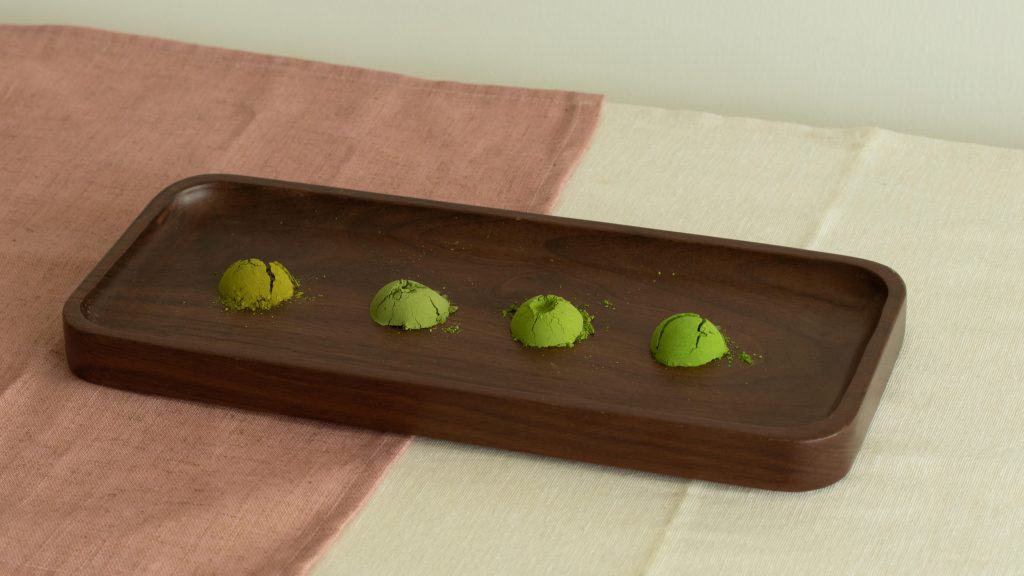
Understanding the real difference between ceremonial and culinary grade matcha
Outside Japan, most matcha consumers divide matcha into two types of matcha grades; ceremonial grade matcha and culinary grade matcha. The idea is that ceremonial grade matcha is a higher quality, and is good enough to drink near, whereas culinary grade matcha is more suitable for ingredient use in recipes due to its more pronounced bitter taste.
Most people view “ceremonial grade matcha” as more expensive than “culinary grade matcha”. Overall, the general perception is that “ceremonial grade matcha” is high quality matcha and “culinary grade matcha” is low quality matcha.
But is this the best way of understanding matcha grades? We don’t think so.
HOW DO THE JAPANESE EVALUATE MATCHA QUALITY?
In Japan, matcha is not categorized into "ceremonial” or "culinary” grade. In fact, there is no standardized matcha grading system with regulatory effect. Each matcha blend is evaluated based on its unique characteristics such as its color, taste, texture etc. While the labels “culinary” and “ceremonial” grade have caught on overseas, can draw the line wherever they want. It is completely unregulated.

As a result, what is “ceremonial grade matcha” or “culinary grade matcha” is quite subjective. That’s why we feel that they are unhelpful terms.
Here is a summary.
WHY YOU SHOULD NOT FOCUS ON WHETHER MATCHA IS "CEREMONIAL GRADE" OR "CULINARY GRADE"
- It is difficult to cleanly separate matcha into two bands of quality. Matcha is never categorised this way in Japan. It is instead graded based on multiple factors across a spectrum.
- No government or international organisation regulates the use of the “ceremonial grade” classification. The only thing stopping matcha companies from overcharging you for “ceremonial grade”matcha that miss the mark in taste and quality is their integrity.
- Even under the best of intentions, matcha companies cannot accurately define what “ceremonial grade” means and will just apply their own subjective standards.
But knowing that alone is unhelpful. What you need is a framework to independently assess matcha quality. Then you can decide if a matcha product on offer is worth its asking price. The purpose of this article to demystify some of those quality factors and equip you with the knowledge to judge for yourself.
INSTEAD, FIND THE MEANING BEHIND CEREMONIAL GRADE AND CULINARY GRADE MATCHA
You must understand exactly what each company means by “ceremonial grade” matcha and “culinary grade” matcha and look deeper into other factors that indicate a matcha’s quality. Ask the matcha company more about their various matcha products. Read reviews, and ask if you can purchase samples if they are available.
WHAT "CEREMONIAL GRADE" AND "CULINARY GRADE" MEANS TO NAOKI MATCHA
We are not great fans of this binary “ceremonial grade matcha” and “culinary grade matcha” distinction. For this reason we adopt it for convenience.
At Naoki Matcha, if the matcha blend can be used to make something you drink, we consider it a ceremonial grade matcha. If it can be used to make something you eat, we consider it a culinary grade matcha. Whatever “grade” we say the matcha is, we’re dedicated to offering the very best matcha from Japan at the price point for your needs.

This is why we have a number of ceremonial grade matcha blends. Each of our ceremonial grade matcha powder are different and tailored to specific use cases – some are best for enjoying iced, some are great for lattes, others are generally quite versatile, and we have a few that are appropriate for practicing the Japanese tea ceremony.
Some are made from specific cultivars, some are single-origin, some are made exclusively of first harvest leaves, others a blend.
How to choose between the various matcha we offer is beyond the scope of our article. We recommend visiting our buyer’s guide . If you still have further questions, send us an email we’re more than happy to help.
CULINARY GRADE OR CEREMONIAL GRADE MATCHA FOR LATTES?
Culinary or ceremonial matcha for matcha lattes?We get this question all the time. The best type of matcha for lattes is to use either our Superior Ceremonial Matcha or Organic Ceremonial Matcha. These are much lower in bitterness compared to conventional “culinary grade matcha”, which makes them very versatile.
Because they are less bitter, you can add much reduced levels of sweetener. You can use our other ceremonial grade matcha powder blends to make lattes, but the costs will quickly add up. Most of the nuanced flavors will also be lost amidst the milk and sweetener.
WHAT IS CULINARY GRADE MATCHA BEST USED FOR?
The “Culinary grade” matcha is usually the best matcha for baking or cooking. However, the culinary grades matcha available in the market are often too astringent, barely discerning any matcha flavor in baked goods.

SO HOW SHOULD YOU ASSESS MATCHA QUALITY?
If a brand claims that their product is “ceremonial grade matcha” as a marker of quality, here are some criteria you can use to assess the actual quality of the matcha.
Read reviews, ask a representative. You should always try to obtain more information based on these few criteria. Most tea companies are more than happy to share it!

1. Where was it produced?
The best matcha is made in Japan, but you should also check the region of Japan where the matcha was produced. Uji in Kyoto Prefecture is famous as the birthplace of matcha and Japanese green tea. Naturally, matcha from Uji is expected to be good but there may be a price premium because of the brand name. Yame is a city in Fukuoka Prefecture which is famous for gyokuro tea, and has begun to make good matcha. Shizuoka and Nishio (both nearer to Tokyo) are also known for matcha. Kagoshima Prefecture and Wazuka town in Kyoto Prefecture mostly produce sencha, but many growers are branching out into matcha and are getting quite good at it.
2. Was it grown under shade before harevset?
The shading process is the most important step in matcha cultivation. In the few weeks leading up to harvest, the tea plants are deprived of sunlight and grown under shade. This changes the amino acid profile of the tea leaves and gives matcha its signature mellow, umami taste. The different shading techniques and duration of shaded growth are important variables for the grower to decide.
3. What tea plant cultivar was the matcha made from?
The vast majority of tea produced in Japan is made using the Yabukita cultivar. This cultivar is used to produce everything from bottled tea to matcha. Certain cultivars, like the Asahi cultivar, are normally associated with high end matcha from established tea brands. However, this topic is quite nuanced and we recommend you read our article examining cultivars for further clarity.
4. When was it harvested?
The first harvest (otherwise known as the first flush or Shin Cha) is typically the best because the tea plants have retained the nutrients accumulated over winter. Matcha of the highest quality would be made using only first harvest tea leaves, while others may comprise a blend of first or second harvest leaves to keep costs low.
5. How was it processed and stored?
After harvest, the tea leaves are sent to a factory to be steamed, dried, sorted and cut. Veins, stems and impurities are removed. The processed leaves (tencha) should be stored in a refrigerated room if not being immediately ground into matcha. Storing tencha (or matcha) at cooler temperatures is important to preserve freshness. Ground matcha should have the same texture as talcum powder and should not feel grainy. If any of these criteria are not met, we would have serious doubts about the quality of the matcha.
6. What color is it?
A vibrant green is important and is indicative of freshness. Yellowish matcha powder suggests that the matcha has become stale or that it was made using the leaves harvested from the bottom of the tea plant. However, be aware of possible variations between the shades of green. Kagoshima matcha is known for being slightly darker green because of the surrounding area’s volcanic soil, but would still appear vibrant. Other cultivars like the Seimei cultivar are known for being extremely bright green. Just like fresh vegetable produce, the key is the vibrancy of the green color. Regardless of grade, the green color of matcha should look “fresh” and not faded.
7. How does it taste?
It’s difficult to really understand how the matcha would taste by reading a description online. The above factors will give you some expectation as to how the matcha may taste. But even then, there is an element of subjectivity which may affect your experience. Wherever possible, we always recommend asking the seller for some small samples. Some may impose a token charge to pay for shipping and product costs, but asking for samples is something we always recommend as an important and prudent step for more expensive teas.
This is the first of several articles that go into greater detail on how to understand the different factors that affect the quality of matcha. Please read the next article to learn more about how matcha is produced.
